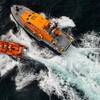BP's new fleet of oil tankers, already dogged by cracked rudders and missing anchors, now has a new glitch, according to a report on www.scrippsnews.com. Fleet managers have been forced to replace mooring bitts on three of four ships after tests showed they were defective and one broke down.
On Sept. 12, the tanker Alaskan Navigator was approaching the dock in Valdez when a bitt on the starboard bow broke off as a tug boat pulled on a mooring line, according to people with the U.S. Coast Guard, the ship's operator and a Valdez-based oil-industry watchdog group.
When it broke, the heavy iron bitt shot over the side of the ship and plunked into the water.
Fortunately, no one was in the way when the bitt broke loose, said Cmdr. Michael Gardiner, captain of the port for the Coast Guard in Valdez.
"If you were standing near it, it probably would have scared you pretty good," he said. "It was a pretty big piece of metal flying through the air."
The ship's operator, Alaska Tanker Co. of Beaverton, Ore., used X-rays and other tests to determine that the failed bitt plus dozens more on three ships were defective and needed to be replaced.
The bitt problem is the latest bobble for the new fleet of $250 million double-hull tankers, the first of which began carrying North Slope crude oil to West Coast refineries in the summer of 2004.
In spring 2005, two of the ships were laid up for weeks after cracks were discovered in their rudders.
And in December, two ships, including the Alaskan Navigator, each lost a 16-ton anchor as the tankers sailed across the rough Gulf of Alaska with loads of oil.
Managers with Alaska Tanker Co., whose ships carry oil exclusively for BP, said the rudders have been repaired and the anchors that cracked and fell into the sea have been replaced.
The new double-hull ships built by another oil company, Conoco Phillips, don't seem to be having the same kind of problems, he said.
The oil companies were required to replace their single-hull oil tankers with double hulls after the Exxon Valdez oil spill in Prince William Sound in 1989. Today, the shipping revolution is all but complete as most every ship now calling on Valdez has a double hull, a feature believed to reduce the risk of a catastrophic release of oil should, for example, a ship run aground on rocks. (Source: http://www.scrippsnews.com)
Sponsored Content
Experience Custom Yacht Signs and Designs Tailored to Perfection!

April 2025
 Read the Magazine
Read the Magazine

 Read the Magazine
Read the Magazine
This issue sponsored by:

Saltchuk Doubles Down on Workforce Development Investments
Subscribe for
Maritime Reporter E-News
Maritime Reporter E-News is the maritime industry's largest circulation and most authoritative ENews Service, delivered to your Email five times per week








